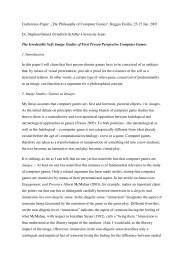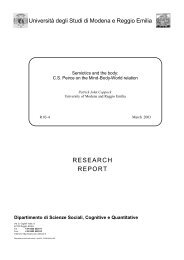Playing Dress-Up: Costumes, roleplay and imagination
Playing Dress-Up: Costumes, roleplay and imagination
Playing Dress-Up: Costumes, roleplay and imagination
Create successful ePaper yourself
Turn your PDF publications into a flip-book with our unique Google optimized e-Paper software.
<strong>Playing</strong> <strong>Dress</strong>-<strong>Up</strong> Ludica<br />
As Judith Butler points out “Gender is always a doing, though not a doing by a subject who might be said<br />
to preexist the deed…There is no gender identity behind the expressions of gender; that identity is<br />
performatively constituted by the very 'expressions' that are said to be its results.” (Butler 1990, p.25)<br />
In online games, in particular, gender becomes a site of performance <strong>and</strong> play, with both males <strong>and</strong><br />
females experimenting with its manifestations <strong>and</strong> extremes. This form of play is not typically associated<br />
with gender dysphoria or homosexuality; in fact, quite the contrary, it is most prevalent among<br />
heterosexual males. Even before fantasy games migrated to the computer, trans gender play has long been<br />
a staple of role-playing games, back to the days of Dungeons & Dragons. It is estimated that while<br />
around 50% of game characters are female in a typical role-playing MMOG, only 10%-20% of players<br />
are, suggesting that about half of the female characters are being played by males. (Yee 2003; Seay et al<br />
2004) Male-to-female trans-gender play is by far the most common, <strong>and</strong> while prevalent in all age groups,<br />
is particularly high among men between the ages of 22 <strong>and</strong> 35. While finding reasons for gender-bending<br />
is obviously more difficult that tracking its existence, Yee, who has done the most extensive study on this<br />
topic to-date, posits a few theories that are relevant to dress-up play practices:<br />
• Social gender boundaries are more stringent in real-life for men, <strong>and</strong> in an anonymous<br />
space, men are more likely to explore gender roles.<br />
• Female avatars receive more “freebies” <strong>and</strong> are treated “better” than male avatars.<br />
• Male gender-bending is another form of dominating the female body.<br />
• In PvP [player vs. player] games, female avatars are perceived to be weaker <strong>and</strong> this<br />
might give the player a psychological edge against unsuspecting chauvinistic players.<br />
(Yee 2003)<br />
In fact, the most common reason for playing a female avatar cited by male players is that they prefer the<br />
way they look.<br />
One thing is certain, however. Males derive equal enjoyment from dress-up play as women, <strong>and</strong> the<br />
digital context may in fact make dress-up more socially acceptable for men. In games with an<br />
instrumental/armor mechanic, males display a high level of concern with both the statistical value of their<br />
garments, <strong>and</strong> their physical appearance, although couched in that male term of “gear.” In more paidiaoriented<br />
worlds, fashion is “out of the closet” so to speak, <strong>and</strong> males have a great deal more freedom to<br />
explore a wide range of dress-up opportunities. In There.com, for instance, men will costume themselves<br />
for particular occasions, or even for no occasion at all. Cowboys, pilot garb, renaissance, or science<br />
fiction attire are all common (Star Trek uniforms being particularly ubiquitous.) Some male players also<br />
have as their primary or secondary character a female avatar, with which they may explore their<br />
“Fashionista” side to a greater degree due to the much more extensive repertoire of female fashions.<br />
These female-presenting men often tend to develop a singular fashion style that would not be afforded<br />
while presenting in their male avatars. Thus the cross-gender play opens up new avenues of personal<br />
expression. A common social activity afforded by There.com’s public “try-it” feature is the oftenspontaneous<br />
dress-up party. Male players will regularly engage in this activity with their female avatars,<br />
both modeling <strong>and</strong> critiquing the designs along with the female players present.<br />
There.com possesses a somewhat unique mechanic that also influences gender play. Unlike most other<br />
MMOG’s <strong>and</strong> virtual worlds, which use text chat as their primary communication mode, There.com uses<br />
voice. In her ethnographic research, Pearce observed only one case of a male player adopting a female<br />
voice, while typical male players inhabiting female avatars speak in their natural, male voices. In this<br />
context, it is not at all uncommon to hear a male voice issue forth from a female avatar. (Pearce 2006B)<br />
Philosophy of Computer Games 2007 Page 18






